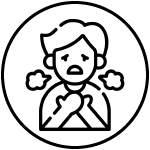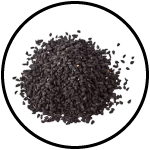Bronchial Asthma (Dīq al nafs/Intisab al-Nafas/Rabw/Buhr/dama), is an old disease for health care system. The clinical sign and symptoms of asthma is traced since previous more than 3 thousand years as recorded in Eberus paperus that is an Egyptian manuscript. (Anjum, 2021)
Asthma is known as a disease of prime public health importance by the World Health Organization (WHO). It is a chronic disease of the lungs that tends to exist as a lifelong condition. It is a disease in which your airways gets narrow and swell and can produce more amount of mucus. This can make breathing hard and cause coughing, a whistling sound (wheezing) when you exhale and shortness of breath. Severe asthma may cause trouble talking or being active. For some people, it’s is a minor disease. For some people, it can be a major trouble that interferes with daily-life activities and may be a cause of life-threatening asthma attack. (WebMD, 2022)
Prevalance
It is one of the most frequent long-term diseases worldwide and it is estimated that more than 300 million people are suffering from asthma, and research confers that in 2025, this value may become around 400 million. The prevalence of lifelong asthma was around 1 to 18% of the general population of different countries. As per recent data from the general population, the overall incidence rate of asthma was reported to be 23/1,000 children each year, 1- 5 years old; which is less among youth aged between 12–17 years old to 4, (i.e. 4/ 1,000/year). For adults, the data has reported that adult females are more likely (1.8 times) to suffer from asthma than adult males (i.e. 4.9/1000 in females vs. 2.8/1000 in males). The National Health Interview Survey (NHIS)-2012 suggests that 40 million of the USA population (about 13%) are suffered from lifetime asthma; while 26 million (about 8%) have been reported as current asthma. The above data and research suggests that it is certain that in near future, asthma will be considered a more chronic and panic-causing problem for the countries globally.(Ahmad et al., 2019)
History
In Unani medicine, the term “Rabu-e-Revi” is used to define asthma. The literal meaning of “Rabu-e-Revi” is difficult breathing and asthma in many of Arabic to English and Arabic to Urdu dictionaries.
This disease was first define by Unani Scholar Hakim Ajmal Khan (1866-1927) as:“It is a dreadful disease whose treatment is very difficult. It is characterized by bronchospasm resulting in dyspnoea ( shortness of breath)”.
The history of asthma is very interesting, Romans used to treat the patients of this disease with the blood of owl , later the Unani scholars treated this disease by the use of Unani medicines successfully, which even the modern medical scholars, are following. The modern researchers invented bronchodilators and corticosteroids that made the treatment much easy.
The complete cure of asthma is yet to be achieved apart from all these advancements. After 1970, in the Unani system of medicine, many unani types of researches have been run on several diseases related to lungs, but only a few research works have done on this disease.
In 130-200 AD Galen was the second Unani scholar who in his most popular book Firdaous ul Hikmat described the detailed treatment of Asthma and he also gave the very first classification of Asthma.
In 860-932, AD Razi explained a most authentic and complete description of asthma in his book Al Hawi fit Tib. He described the most extreme form of asthma as intasabun nafas (status asthamaticus).
In 930-994 AD Ali bin Abbas Majoosi put forward the etiology asthma and described that Asthma and shortness of breath are caused by bronchospasm.
In 980-1037 AD Ibne Sina a Unani physician and noble scholar of explained in detail the disease relative to its etiology, types and other diseases like asthma.(Akhtar et al., 2011)
Mahiyat-e-Marz (Pathology)
It is caused by chronic inflammation of the bronchi and bronchioles (the conducting zone of the airways), which ultimately results in increased contractions of the surrounding smooth muscles. This with other factors results in narrowing of the airway and the classic symptoms like bouts of wheezing. The narrowing is normally reversible with or without treatment. Sometimes the airways alter themselves. Some of these changes in the airways involve an increase in eosinophils and thickening of the lamina reticularis. Chronically the airways smooth muscle gets an increase in size with an increment in the number of mucous glands as well. Other cell types that involves: T lymphocytes, macrophages, and neutrophils. There may also include other parts of the immune system including: ctokines, histamine, chemokines, and leukotrienes among others.
According to the Unani system of medicine the basic reason of shortness of breath in asthma (Ḍīq al-Nafas) is narrowing of Bronchioles (Urooq-e-Khashna) that may be caused by Inflammation of air passages (Waram), exudation and accumulation of Balgham Lazij (Insibab-e-Mawaad-e-Nazla) i.e. (viscid phlegm), Thoracic congestion (Imtila-e-Sadr), air pollution (Abkhira Dukhaniyya) and dryness (Yabusat). When Asthma occurs in relation to other diseases like Pleurisy (Zaatul Janb), Pulmonary Tuberculosis (Sil-wa-Diq), Pneumonia (Zaat-ur-Riya), Anemia (Nuqsuddam), Chronic Bronchitis (Shoib-e-Muzmin), Nephritis (Warm-e-Gurda), it is known as Ḍīq al-NafasShirki. (Alam et al.)
Types of DIQ AL-NAFAS
Rabban Tabari (838-923 AD) a great Unani scholar has described many types of Diq al-nafas in his treatise such as: 1. Diq al-nafas Qasir: caused due to weakness of the respiratory muscles.
- Diq al-nafas Mutataba`e : caused as a result of inflammation of the diaphragm or excessive heat
- Diq al-nafas Mustaqeem: caused due to weakness or atony of the respiratory muscles.
- Diq al-nafas Qawi: caused as a result of Iltehab and hararat.
- Diq al-nafas Zaeef: caused due to Baroodat.
- Diq al-nafas Aseer: occur because of agglomeration of viscid secretions in the bronchioles or gaseous collection in the thoracic cavity putting pressure on the bronchial tree externally.
During the pre-independence era Hakim Ajmal Khan the great scholar of Unani Medicine has explained the following types:
- Diq al-nafas Yabis (Bronchial Asthma with no expectoration) caused by contraction in the bronchial tree and the respiratory muscles.
- Diq al-nafas Martoob (Bronchial Asthma with expectoration) caused by spasm with phlegm accumulation in the bronchial tree.
During Mughal period Hakim Azam Khan eminent physician of Unani system has described the following types:
- Rabw Nazli (Allergic Asthma)
- Rabw Barid (Asthma )
- Rabw Warmi (Potter’s Asthma)
- Rabw Istarkhai (Asthma due to paresis of respiratory muscles
- Rabw Balghami (Catarrhal Asthma)
- Rabw Dukhani (Asthma due to pulmonary insufficiency)
- RabwYabusi (Asthma due to fibrosis of lungs)
- Rabw Haar (Hot type Asthma) (Alam et al., Anjum, 2021)
Alaamaat wa Nishaniyan (Symptoms and Sign)
Wheezing
Wheezing is nearly always present when breathing out during an attack. The attack usually starts with wheezing and rapid breathing, and all breathing muscles become visibly active, when it becomes more extreme.

Shortness of breath dyspnea
Breathlessness is a main source of distress in asthmatic patients. Severe dyspnea (shortness of breath) does not always reflect a serious attack or reduced functioning of lungs. According to Ismail Jurjani, Diq al-nafas is recognized by episodes of breathlessness with or without cough, cold and fever.

Coughing
In some people the basic symptom is a cough without sputum. Episodes of breathlessness and cough may last for 2-3 hours to 24 hours

Chest tightness (pain)
Chest tightness in the beginning with no other symptoms is an early sign of a serious attack. The neck muscles gets tighten, and talking becomes hard or impossible. Chest pain can be very intense, although its severity is not always related to the severity of the asthma attack itself.
Symptoms may be mild, medium and severe. Patient seems restless and weak, face of patient become red and pulse become Saree (rapid), Azeem/ magnus, and Layyin (soft), ocassionaly sweating, hypothermia and increased respiratory rate. (Gholve et al., 2015, Anjum, 2021)

Wajohaat (Causes)
Rabban Tabari (838-923 AD) a great Unani scholar has described many types of Diq al-nafas in his treatise such as: 1. Diq al-nafas Qasir: caused due to weakness of the respiratory muscles.
- Diq al-nafas Mutataba`e : caused as a result of inflammation of the diaphragm or excessive heat
- Diq al-nafas Mustaqeem: caused due to weakness or atony of the respiratory muscles.
- Diq al-nafas Qawi: caused as a result of Iltehab and hararat.
- Diq al-nafas Zaeef: caused due to Baroodat.
- Diq al-nafas Aseer: occur because of agglomeration of viscid secretions in the bronchioles or gaseous collection in the thoracic cavity putting pressure on the bronchial tree externally.
During the pre-independence era Hakim Ajmal Khan the great scholar of Unani Medicine has explained the following types:
- Diq al-nafas Yabis (Bronchial Asthma with no expectoration) caused by contraction in the bronchial tree and the respiratory muscles.
- Diq al-nafas Martoob (Bronchial Asthma with expectoration) caused by spasm with phlegm accumulation in the bronchial tree.
During Mughal period Hakim Azam Khan eminent physician of Unani system has described the following types:
- Rabw Nazli (Allergic Asthma)
- Rabw Barid (Asthma )
- Rabw Warmi (Potter’s Asthma)
- Rabw Istarkhai (Asthma due to paresis of respiratory muscles
- Rabw Balghami (Catarrhal Asthma)
- Rabw Dukhani (Asthma due to pulmonary insufficiency)
- RabwYabusi (Asthma due to fibrosis of lungs)
- Rabw Haar (Hot type Asthma) (Alam et al., Anjum, 2021)
Diagnosis
Medical History
Doctor may ask:
- About individual medical history, includes information about allergies, asthma or other medical conditions.
- If one had a sour taste in the mouth or heartburn. That may be signs of gastro esophageal reflux disease (GERD).
- If one had an episode of flu-like symptoms or cold.
- Smoking or spends time around others who smoke.
Physical Examination & Investigations
To check on signs of problems related to cough your doctor will use a stethoscope to listen to your lungs. Doctor will listen for wheezing (a whistling or squeaky sound when you breathe) or other abnormal sounds. There are many other tests which may include:
Chest x ray
It takes a picture of heart and lungs. This test can help diagnose conditions such as lung cancer and pneumonia.
Lung function tests
These are detailed tests that can shows how much air you can breathe in and out, how fast you can breathe air out and how well your lungs transfer oxygen to your blood. Lung function tests can help to diagnose asthma and other conditions perfectly.
Peak-flow-meter
Peak flow meter is a simple hand-held instrument which can be used by you to measure one aspect of lung function and monitor your asthma control at the other hand. It helps to detect if someone has asthma, determine how bad an attack as well as assess the density of control. Your doctor can guide you how to use this at home, so that you can be cautious about how to increase medicine dose and when to seek urgent medical help.
An X- ray of the sinuses
X-ray test can help to diagnose a sinus infection. (Nhp.gov.in, 2022)
Recommended Diet (Ilaj-bil-Ghiza)
All Aghziya-e-Harra Yabisa recommended. Ghiza-e-Lateef (easy to digest) and Musakhkhin (producing heat) which is Maa-ush-Shaeer (Barley Water), Maa-ul-Asl (Honey Water), Chuqandar (Beet root), Chicken soup (yakhni), Almond oil, Spinach (palak), Kaddu (Pumpkin), Saib (Apple), Behi (Quince), Hareera, Mutton soup (yakhni), etc. have been advised for such patients. Restricted diet All Aghziya-e-hareef (oily and spicy food, Red chilli etc.). Citrus fruits (Lemon,Grapes, Oranges etc.) sour dishes like pickle, Chilled water and Aghziya-eMuwallid-e-Balgham i.e. phlegm producing foods are to be restricted. (Alam et al.)
Food to be Avoided
Food to be avoided including lassi, rice, sour fruits, ice, beer, cool drinks, egg, meat, fish and groundnuts. Excess intake of food must be avoided. Care should be taken to avoid exposure to cold, smoke, dust, polluted environment, excess of exercise, excess of walking, daytime sleep and overindulgence in sex. Many of clinical trials have been conducted on different herbs which used in the in formulations of Ayurvedic medicines were found to be effective. (Gholve et al., 2015)
Ilaj Bit Tadbir (Regimental therapy)
Human being depends on medicinal plants since the time of immemorial for the treatment of many diseases. It has been estimated that about 80-85% of population both in developed and developing countries depends on traditional medicines for their primarily health care needs and it is assumed that a major part of traditional therapies involves the use of plant extracts or their active components.
Because of lack of organized health care systems in developing countries, people with chronic diseases like asthma are among the worst sufferers in their communities. Hence, the majority of populations still have limited access or no access, especially those in remote areas to modern medicines. Instead, they use the traditional medicines for a range of disease complications.
Unani medicines has described a number of plants, which have been used by the physicians for management of the bronchial asthma. e.g. Aroosa (Adhatoda zeylanica Medic), Joz Masil (Datura innoxia Mill.), Kalongi (Nigella sativa Linn.) and Kakra Singhi
The active principles of many plants species are isolated for direct use as a drug, lead compounds and pharmacological agents.
Adusa (Adhatoda vasica)
Alkaloids isolated from the Adhatoda vasica showed pronounced protection against allergen-induced bronchial obstruction in the guinea pigs (10 mg/ml aerosol).

Kalonji (Nigella sativa)
Nigella sativa (black seed) oil is use as a natural remedy for a wide range of diseases which includes various allergies. In a clinical study trial, it was found that black seed oil showed anti allergic activity in allergic rhinitis, bronchial asthma and atopic eczema. It is the effective adjuvant for treatment of many allergic diseases.

Kashim/Chatim (Alstonia scholaris)
Alkaloids of Alstonia scholaris significantly inhibit frequency of cough in mice induced by ammonia, increased mice’s latent period of cough induced by sulfur dioxide and increased guinea pigs’ latent period of cough and inhibiting the frequency of cough. Anti-tussive, anti-asthmatic and expectorant activities components of Alstonia scholaris leaf and it may also be a valuable lead material for respiratory diseases drugs development. Picrinine, the main anti-tussive and anti-asthmatic compound, would be applied in quality control of products from Alstonia scholaris leaves.

Kutki (Picrorhiza kurroa)
Androsin from Picrorhiza kurroa prevention allergenand PAF-induced bronchial obstruction (10 mg/kg orally; 0.5 mg inhalative). Histamine release in vitro was inhibited by other compounds of the plant extracts. (Akhtar et al., 2011)

Compound Unani formulations
Kushta Abrak Siyah, Sikanjabin Unsuli, Habb-e-Hindi Zeeqi, Safoof-e-Dama Haldiwala, Sharbat-e-Zufa Murakkab, Lauq-e-Rabvi, Lauq-e-Sapistan, Lauq-e- Zeequn nafas, Lauq-e-Katan, Laooq-e-Nazli, Intesaabi, Majoon Rahul Momineen.
Tahaffuz (Preventive measures)
- Avoidance of constipation
- Avoid exposure to excessive cold, dusty and mois environment
- Avoid physical and mental stress
- Avoid use of citrus fruits, red chillies and oily food
- Avoid use of diuretics because it may be increase the consistency of Balgham. (Alam et al.)
Common Myths
- You need to take medication only during an asthma attack: Patients with persistent asthma (mild, moderate or severe) needs to use the preventer (controller) medications on a long-term basis to prevent such attacks in the future.
- A child with asthma will outgrow the disease: The disease would be probably become milder and less symptomatic. Although it’s a chronic condition, there are excellent means to maintain this disorder.
- Patients with asthma should not take part in physical exercise:Exercise is good for asthma patients just as well as for those without it. Proper medical advices are essential before undertaking such activities.
- Its cure can be achieved with transfer of residence to a “better” climate: Proper use of medicines and usual precautions at home and workplace is most important to achieve asthma control.
- “Inhalers” are the last resort for control: Asthma medication is ideally administered from the inhaled route so as to ensure prompt and targeted drug delivery with least side effects. It is true for even the mildest form of disease.
- “Inhalers” are addictive or habit forming:These are not habit-forming medicines at all. However, asthma being a chronic disease, they may be required to be administered on a long-term basis under proper medical guidance.
- Steroids used in asthma are dangerous drugs: The benefits of inhaled corticosteroids that are used in asthma are far more than the risk involved. This is true even in children of growing age. The use of asthma medications should be under medical guidance.
- It’s a psychological disease:Asthma is not a psychological disease although emotional factors can be triggering an asthma attack.
- It is contagious disease:This is not a true.
- Patients should avoid “cold” food like milk, curd etc.:There are no food restrictions for asthma. However, in case there is an identifiable food item that has been known to trigger asthma attacks in a particular patient, this item will be avoided.
- Regular use of asthma medicines makes them ineffective:This is an incorrect statement. Some medicines are effective only if use regularly. Use of any asthma medications should be under medical guidance.
- In children nebulizers are the ideal method of administering asthma medication:Metered dose inhaler with spacer and mask device are equally effective in drug delivery in children.
(Nhp.gov.in, 2022)




